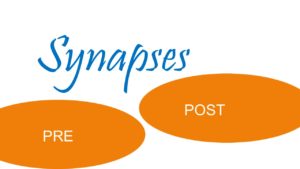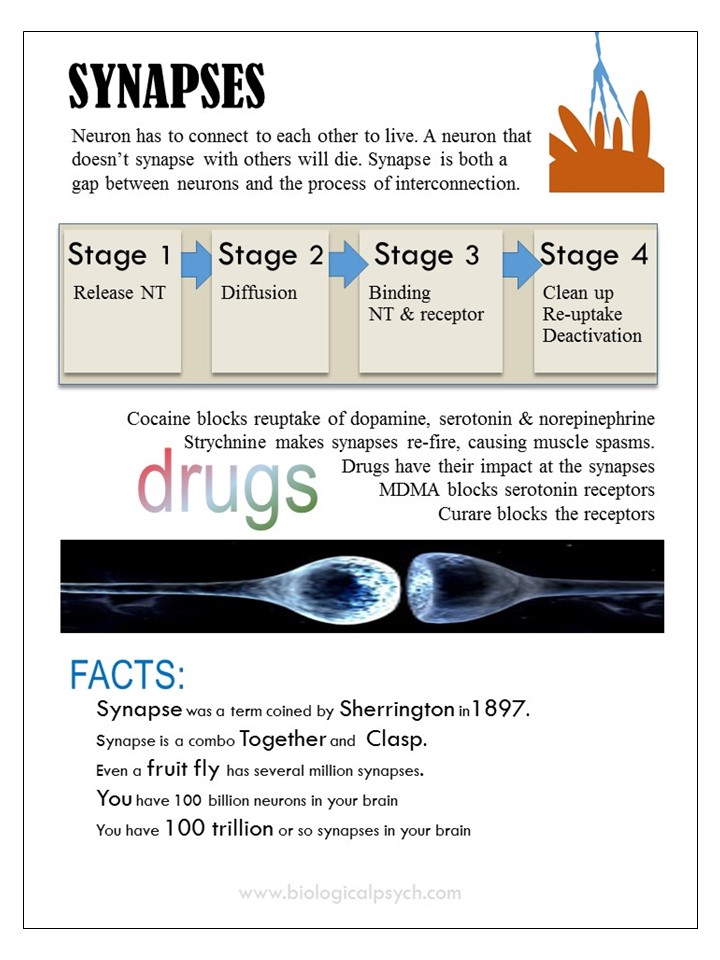
WARNING: sin apps on your phone are not the same as synapses in your brain. But both can lead you astray.
Good thing. It’s easy to misplace your phone, which results in inconvenience. But you’re not going to be of much use if you forget where you left your neural connections.
Don’t let the silly mnemonic fool you. These gaps between neurons are important. Everything you do, think or feel depends on neurotransmitters making it across synapses. Diseases, drugs and chemicals that stop synaptic function, stop your muscles from working, your heart from beating, and your brain from living.
A lot can happen betw een neurons. These separations are called synapses. Structurally, synapses are intercellular spaces (between cells). They are small separations between neurons.
een neurons. These separations are called synapses. Structurally, synapses are intercellular spaces (between cells). They are small separations between neurons.
Synapses can be electrical or chemical. They are the location where drugs and chemicals impact behavior. Pay particular attention to how chemical bonds are formed and how synapses are cleaned up.
Learning Objectives
- Describe how synapses influence action potentials
- Describe which observations Sherrington used to infer the existence of synapses
- Explain the sequences (phases) of synaptic activity
- Explain diffusion, binding, reuptake and deactivation
- Describe how drugs impact synapses
- Compare and contrast the major neurotransmitters
Read
Read these posts (if there are links:
- Synapses and drugs
- Diffusion
- Binding and unbinding
- Reuptake and deactivation
- 3 types of synapses
- ionotropic & metabotropic effects
Videos
Slides
Links
- Neuroscience for Kids: The Synapse
- Alzheimer’s Association: Cell Signally
- Scientific American: The Synapse
Terms
- acetylcholine
- acetylcholinesterase
- amino acids
- ATP (adenosine triphosphate)
- axon-axon
- axon-dendrite
- axon-soma (axosomatic)
- binding
- cascade of reactions
- catecholamines
- curare
- diffusion
- endocytosis
- enzymes
- EPSP’s (excitation)
- essential amino acids
- exocytosis
- GABA (inhibitory)
- GABA transporters
- GABAa = ionotrophic
- GABAb = metabotropic
- GABAergic synapses
- GABA-glutamine cycle
- gases
- glutamate (excitatory)
- glutamate decarboxylase
- glutamate transporter
- glutamate-glutamine cycle
- glutaminase (enzyme)
- glutamine
- glutamine synthetase enzyme
- G-protein
- GTP (guanosine triphosphate)
- histamine
- inactivation
- inhibitory
- integration
- ionotropic effects
- ionotropic receptors (iGluRs)
- IPSP’s (inhibition)
- ischemia
- localized effect
- metabotropic effects
- metabotropic receptors (mGluRs)
- mitochondria
- mitocondira
- monoamines
- MSG (monosodium glutamate)
- neuron terminal
- neuropeptides
- neurotransmitters
- nicotinic receptors
- nitric oxide (NO)
- NMDA channels
- poloypeptides
- postsynaptic cell
- presynaptic cell
- proteins
- purines
- receptor
- reflex arc
- regulation
- reuptake
- second messenger
- serotonin
- Sherrington
- spatial
- succinate
- summation
- synapses
- synaptic crosstalk
- temporal summation
- transporters
- tryptamines (serotonin-melatonin)
- unessential amino acids
- vesicles
Notes
- Typical Electrical Neuron & Chemical Synapse
- At Neuron Terminal
- Depolarization causes calcium gates open
- Calcium flows into terminal
- NT is released
- within 1-2 milliseconds
- Sherrington
- Reflex Arc
- Synapse
- Thousands of synapses along neuron
- Three types
- 1. Axon-Soma (axosomatic)
- Usually inhibitory
- 2. Axon-Axon
- Electrical
- 3. Axon-Dendrite
- Dendrites
- Chemical
- 1. Axon-Soma (axosomatic)
- 40 nanometers
- Sheet of paper 100,000 nm
- Hair 40,000 nm
- Red blood cell 7,000 nm
- Bacteria 5,000 nm
- Virus 30-50 nm
- Ultraviolet light 40 nm
- Synapses 40 nm
- Cell membrane 10 nm
- DNA 2.5 nm
- Fill the gap with chemicals
- 4 Stages
- 1. Release the chemical
- Pre-synapse
- 2. Float across synapse
- Diffusion
- 3. Bind with receptor
- Not just anyone
- Matching key
- Nicotinic receptors
- Activated by nicotine
- Blocked by curare
- Nicotinic receptors
- 4. Clean up the gap
- Destroy leftovers
- Recycle (reuptake)
- Release and Diffusion
- Release of NT thru membrane
- Exocytosis
- Lasts 1-2 ms
- No more than 0.01 ms across a 20 to 30 nanometers wide cleft
- Opposite of endocytosis
- Cells absorb protein molecules
- Only release 2-3 transmitters
- always the same combo
- Exocytosis
- Release of NT thru membrane
- Ionotropic effects
- used for quick events
- visual stimulation
- muscle movements
- quick start (10 ms)
- short duration (30 ms)
- localized effect on membrane
- opens gates for ions
- e.g.,acetylcholine
- Most common
- glutamate (excitatory)
- GABA (inhibitory)
- used for quick events
- Metabotropic effects
- Slow start (30 m)
- Can last for hours
- Has broad impact
- Can affect most of a cell
- opens or closes ion channels
- changes protein production
- activates chromosomes in cell
- Activates G-protein inside membrane
- G-protein activates 2nd messenger system
- G-proteins
- Little protein that sits close to receptor
- coupled to energy-storing molecule GTP (guanosine triphosphate)
- Changing cell causes the G-protein to change shape
- Part of G breaks off to bind to a site on an ion channel
- Binding causes ion channel to open
- G-proteins can also activate enzymes
- Enzymes causes production of second messenger
- Second messenger binds to ion channels to open them up
- Little protein that sits close to receptor
- After causing action potential, after exciting or inhibiting
- Inactivation
- broken down by an enzyme
- acetylcholine is broken down by Acetylcholinesterase
- Reuptake
- detach from the receptor
- taken back by presynaptic cell
- Transporters
- Serotonin is reuptaken
- Inactivation
- Characteristics
- Summation
- also called integration
- neuron can receive input from 1000+ cells
- each input either excites or inhibits
- interaction between incoming EPSP’s (excitation) and IPSP’s (inhibition)
- 1. Temporal summation
- 2. Spatial
- Summation
- Neurotransmitters
- Brain uses dozens of NTs
- No single neuron releases all
- A neuron may respond to different NTs at different synapses
- 300+ types
- 6 Major Types of NTs
- 1. Amino acids
- Building blocks
- Essential (must get from food)
- Unessential (can synthesize)
- 2. Monoamines
- Based on amino acids
- Histamine
- Catecholamines (dop, nor, ep)
- Tryptamines (serotonin-melatonin)
- Trace amines
- 3. Neuropeptides
- Chains of amino acids
- Neuropeptides = small chains
- Poloypeptides = long chains
- Proteins = very long chains
- 4. Acetylcholine
- Individual neurotransmitter
- First NT discovered
- 5. Purines
- Not stored in vesicles
- Adenosine and derivatives
- ATP (adenosine triphosphate)
- Synthesized in mitochondria
- Easily combines to make reactions
- Present in cytoplasm of every cell
- High-energy molecule; stores energy
- 6. Gases
- Nitric oxide (NO)
- possibly others
- 1. Amino acids
- Most Common In Brain
- Glutamate 90%
- GABA 9%
- Other 1%
- Glutamate
- Amino acid
- Building blocks of proteins
- MSG (monosodium glutamate)
- Non-essential (body can create)
- Glutamine
- Serine
- Taurine
- Glutamate to Glutamine
- Glutamate & Amonia
- Glutamine Synthetase enzyme
- 90% of glutamine synthesized in muscles
- Small amounts also released by lungs and brain
- Liver could synthesize glutamine but doesn’t, regulates it
- Collect glutamine from the gut
- Amino acid
- Glutamate-Glutamine Cycle
- Neurons & glial cells work together to maintain glutamate supply
- Glial cells release glutamine
- Astrocytes
- Sent to presynaptic terminals
- In neuron terminal
- Converts glutamine to glutamate
- by glutaminase (enzyme)
- Sent to vesicles
- Packaged in vesicles by VGULT transporter
- Released & Binds
- Reuptaken by EAAT
- Excitatory amino acid transporter
- 5 types (1 for each receptor type)
- Reuptaken by glial cells
- converted into glutamine
- By glutamine sythetase
- Transported out of cells into neuron terminal
- At GABAergic synapses
- called GABA-glutamine cycle
- Glutamine converts to glutamate
- Glutamate into GABA
- By glutamate decarboxylase
- Upon release, GABA is taken up by glial cells
- GABA transporters
- Glial cells
- Convert GABA into succinate
- Series of steps to alpha-ketoglutarate and then back to glutamine
- Glutamate
- Easily binds
- Excitatory effect
- Important for:
- neural communication
- memory formation
- learning
- regulation
- Used in:
- 50% of body’s synapses; 90% of brain’s synapses
- Problems
- Too much in MS
- Binds too easily in epilepsy
- Not enough in schizophrenia
- MIGHT cause:
- Ischemia
- Thinning of blood vessels
- Restricted blood supply
- Thrombosis, vasoconstriction
- Types of Receptors
- Ionotropic receptors (iGluRs)
- NMDA 4 subtypes
- Kainate 5 subtypes
- AMPA 7 subtypes
- Metabotropic receptors (mGluRs)
- 8 subtypes
- Cascade of reactions
- G protein
- Ionotropic receptors (iGluRs)
- Used as a point-to-point transmitter
- Used as a spill-over transmitter
- Synaptic crosstalk
- summation of glutamate from neighboring synapse causes extrasynaptic signaling
- Glutamate transporter
- Neurons & glial cells
- Rapidly remove glutamate from extracellular space
- Glutamate transporter problem
- In brain injury or disease
- Can work in reverse, builds up excess glutamate outside cells
- Reversed transporter
- Causes calcium ions to enter cells
- Go thru NMDA channels
- Results can be:
- Neural damage & cell death; called excitotoxicity
- Damage to mitocondira
- (high intracellular calcium)
- Might explain:
- Stroke
- ALS
- Autism
- Alzheimer’s
- Implicated in epileptic seizures
- Spontaneous opening of voltage-gated calcium channels?
- Glutamate levels
- Controlled by ATP
- controls glutamate transport levels
- GABA
- From Glutamate
- 9% of brain
- Inhibitory
- Regulates muscle tone
- Impacts opening of
- Negative chloride ions in
- Positive potassium ions out
- Types
- GABAa = ionotrophic
- GABAb = metabotropic
- G-protein
- Low GABA
- Epilepsy?
- High GABA ($ receptors)
- Benzodiazepine
- Barbiturates
- Alcohol
Quiz
- 1. Gaps between axons of one neuron and dendrites of another neuron are called:
- a. ion channels
- b. transporters
- c. synapses
- d. hodos
- 2. The most widely used neurotransmitter in the brain is:
- a. acetylcholine
- b. glutamate
- c. dopamine
- d. GABA
- 3. Removing neurotransmitter from a synapse by re-absorption is called:
- a. summation
- b. inactivation
- c. reuptake
- d. ablation
- 4. Like many neurotransmitters, glutamate has:
- a. only metabotropic receptors
- b. only ionotropic receptors
- c. anti-virus agents in it
- d. multiple receptors
- 5. Who showed that reflexes have synapses:
- a. Sherrington
- b. Huntington
- c. Flourens
- d. Kalat
For the answers: Click Here
Discussion
Any questions about synapses?
Cluster


Leave a Reply